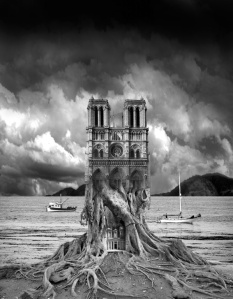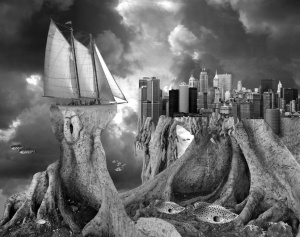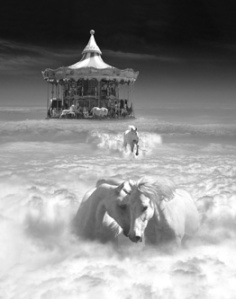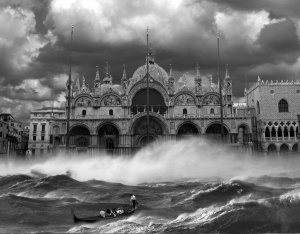Photo manipulation is not a product of the contemporary era. Seemingly archaic techniques of altering images can create quite a loud impression inside of a regular, virgin picture. While museums like the Metropolitan Museum of Art have divided the course of photo manipulation into two sections, before digital aid and after, they have overlooked quite an interesting artist.
This exhibit focuses on Thomas Barbèy’s work. He grew up in Geneva, Switzerland and currently lives in Las Vegas.. He uses techniques of the pre-digital age with images of today’s world. Barbèy predominantly focuses on black and white photographs while sometimes including sepia.
The resulting pieces are the product of photographs taken from twenty years ago to yesterday. His work has been featured in museums in the United States and the United Kingdom, several magazines, and galleries all over the world.
Thomas Barbèy: Today from Yesterday’s View would call The Metropolitan Museum of Art its home serving to bridge the gap between Faking It: Manipulated Photography Before Photoshop and After Photoshop: Manipulated Photography in the Digital Age. For the purpose of this exhibit, the interpretations of Thomas’s pieces are in relation to the sublime in art.
THE SUBLIME
Much of Barbèy’s pieces feature sublime action. According to an article published on Tate Britain’s website, works consistent with the sublime theme “have the quality of such greatness, magnitude, or intensity, whether physical, metaphysical, moral, aesthetic of spiritual.. that our ability to comprehend is temporarily overwhelmed.” Furthermore, Edmund Burke describes sublime as creating a relation “defined by a kind of pleasurable terror.” During the seventeen and eighteen hundreds, sublime “was associated with the immensity or turbulence of Nature and human responses to it (Tate Britain).”
The sublime theme refers to the notion that the human is no longer considered central to the rest of existence; we, as people, are not the sun while everything else is merely a planet that revolves around us (Tate Britain). What civilization has put into place can be taken back by nature in seconds ruining the centuries of development people have devoted. Nature is above.
While sifting through Barbèy’s works, several seemed to be capturing a relationship between nature and infrastructure. The duel between an unstoppable force and an (seemingly) immovable object always had a clear victor.
STUMPED
In the first work, Barbèy depicts the Norte Dame Cathedral in Paris onto a tree stump surrounded by water, mountains, and a stormy sky. Norte Dame was constructed hundreds of years ago yet, the tree, its roots, and the earth from which it grows predates the structure as well as the civilization that allowed it to exist. The cathedral is out of place when its surroundings retreat back to a pure earth and away from infrastructure and society. The tree is in Beverly Hills, Norte Dame is in Paris, the structure at the bottom of the stump is in Petra, Jordan, and the boats were in Monterey, California.
FISH OUT OF WATER:
Barbèy explains that this work is intended to depict the idea that people try so hard to be accepted and adopt whatever is considered “cool” while failing to embrace who they are. However, the sublime theme is still loudly evident. The city and sailboat, both products of people, are placed atop small plateaus in the ocean. Theses symbols of a civilized world are secluded and surrounded by the natural world. The fish, the cloudy sky, and the roots take precedent over the boat and the buildings. The two symbols of people are outnumbered and encircled by the natural world from which they rise.
HORSING AROUND:
This piece is commenting on the monotonous habits that many of us fall into. The horses in the photo are depicted as running away from the trap that is the carousel thus breaking free. Barbèy also notes that the horses heads are “forming the shape of a heart” and all he “could see was beauty, tenderness, and love.” The animals can be seen as representative of the natural world while the carousel can be seen as the manufactured structure trapping them. In Barbèy’s depiction of the escape, the animals are fleeing the carousel and finding shelter in the wispy clouds. The animals escape the constraints that is mankind and feel the freedom that nature offers. Nature has dismantled a product of people.
SOMETHING’S FISHY:
Barbèy was inspired to create this piece by the familiar feeling of being in an ocean and fearing what may be in the dark water. The sand of the ocean floor is shown inside the archways and underneath the buildings of the city suggesting that the city was not built on the ocean floor but that the earth is swallowing it. The groups of fish swim around the structures as if they were not there. The buildings are sunken and although it may have been a thriving city with beautiful architecture it is incapable of resisting the power of the ocean. In fact, the insignificance of the buildings is made evident by the lack of interest that the creatures of the sea exude.
SIGHTSEEING WAS A BLAST:
Upon first looking at this piece, the contrast between the ornate architecture of the building and the simple beauty of the waves is awe striking. The stillness of San Marco Basilica and the Palazzo Ducale versus the action of the water makes for a tumultuous relationship within the picture. Similarly to “Something’s Fishy”, the power of the sea is a constant, adaptive action whereas infrastructure can only resist by relying on the strength of the bricks or stone with which they are made. Not only is nature’s power clearly stronger than civilization’s infrastructure -as with the previously discussed photos- but it is also malleable and adaptive unlike the immobile behavior of a building. The top picture is of San Marco’s Basilica and the Palazzo Ducale in Venice and the water was taken in the Pacific Ocean on a sailboat.
SPECIAL EFFECTS:
Barbèy works with film, negatives, and a dark room setting him aside from the common use of Photoshop or other digital programs used today to alter images. He uses a Canon AE1 in 35mm or RB67.
Barbèy travels several times a year to capture photographs in different places. He sometimes takes pictures with a piece in mind but often, he chooses from he collection of photos ranging from two decades ago to today. He refers to the process as “learning constantly from the process of creation.” Barbèy goes on to explain, “the montages are created by carefully choosing printing procedures, such as combination printing; sandwiching negatives together, thereby printing them simultaneously; pre-planned double exposure in the camera; the re-photographing of collaged photographs; or a combination of the above.”
Barbèy’s choice to use black and white film and a manual process of alteration makes for an interesting result of making contemporary subject matter appear vintage.
FUNCTION
Barbèy’s portrayal of surreal subject matter founded in reality makes for an alarming relationship inside the photo. Thomas emphasizes titles and explains that they are “the glue and substance” of the piece. As seen in all of his works Barbèy’s style creates an image to accompany an idea that most people can identify with. Illustrating an abstract notion is difficult to accomplish especially within the realm of photography. In pencil drawing or sculpture for example, artists are freer in depicting a notion (like fearing what lies in dark water) through fantasy. Creating the same effect through photography adds the obstacle that the components of the piece must be derived from reality even though the goal is to depict a surreal image. Barbèy’s triumph is here. His photographs are perfectly sewn together to portray an abstract feeling or idea with ease.
In terms of photo manipulation in general, Kelli Connell’s claim that her “photographs lie as documents but tell the truth as images” hits the nail on the head (Bey). Editing a picture does not take away from its sincerity. Barbéy’s choice to place ocean waves in front of a basilica adds excitement to a relatively ordinary picture of a building. Photo manipulation adds meaning to an image allowing an audience to see the world through rose colored lenses. Barbèy’s work speaks to the notion that how you see it and how you frame it has different translations. Seeing a carousel as merely a children’s ride means something quite different from framing it as a mundane structure condemning wild horses to an eternity of riding around in circles.
If an artist chose not to take the opportunity to stray away from reality, what would art be? Any technique based on reality (ex. landscape, still life, and portraits) is derived from a person’s perception of what actually is. Artists are constantly confronted by making the decision of what should be included in a piece and what should not in order to make it aesthetically pleasing or meaningful. Even if the choice is as subtle as deciding whether or not to include a window behind a bowl of fruit, it makes a difference. All artists are liars and their works are the proof. Just because Barbéy’s style may lie louder than another’s but his piece are not less worthwhile because of it.
Check out more of his awesome work here.
Sources:
“About.” Thomas Barbèy. Thomas Barbèy, n.d. Web. 6 May 2013.
“Art and the Sublime.” Tate Britain. Tate Britain, 10 Feb. 2010. Web. 14 May 2013.
Bey, Dawoud. “Kelli Connell’s Double Life.” FlakPhoto. FlakPhoto, 21 Oct. 2011. Web. 18 May 2013.
“Thomas Barbèy Fascinating Photo Collage.” Thomas Barbey Limited Edition, Signed Photographs. Artifact’s Gallery, n.d. Web. 16 May 2013.





